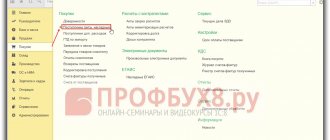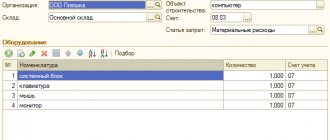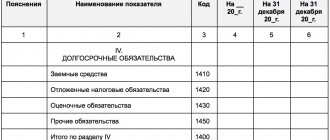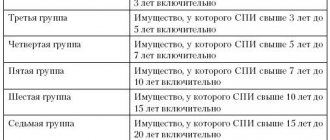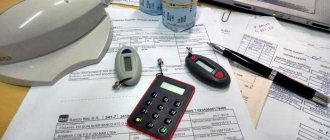How to define a fixed asset object
In the case of buildings, structures, structures and premises, it can be difficult to correctly determine the inventory item. And here it is important to focus on several rules:
- an inventory unit is a separate building or a whole complex of buildings erected on a single foundation that perform one or more common functions;
- adjacent buildings with different functions are different objects;
- if auxiliary buildings support the operation of the main building, they are considered part of it;
- all kinds of outbuildings, fences and other structures that support the operation of several buildings or have an independent purpose (garage, summer kitchen) are counted as separate objects.
For example, a free-standing bathhouse is a building with an independent purpose, a separate accounting object. But the room for the household equipment of the institution’s employees is auxiliary, it ensures the operation of a specific building, therefore accounting does not single it out as an independent room.
The accountant assigns an individual inventory number to each newly received object. It is maintained throughout the entire life of the building/premises by the institution. The institution has the right to come up with the structure of numbers and the logic for assigning them to objects independently.
Groups of real estate objects according to their purpose are determined by the All-Russian Classifier of Fixed Assets (OKOF). Buildings/premises of various types intended for human habitation are considered residential. Non-residential buildings are administrative, industrial, service buildings, including garages and warehouses. In this regard, budget accounting is no different from accounting in commercial enterprises.
How to put on the balance sheet an office space in 1s8 donated
Menu
— News — How to put a donated office space in 1s8 on your balance sheet
The decision made will not affect the calculation of depreciation, but the amount of property tax depends on it. According to clause 52 of Order of the Ministry of Finance of the Russian Federation No. 91n (46), organizations are given the right to choose their own accounting option.
Thus, “it is allowed to accept for accounting as fixed assets” real estate objects for which capital investments have been completed, the corresponding primary documents for acceptance and transfer have been drawn up, the objects are actually in operation, and the documents have been submitted for state registration (clause 52). Such fixed assets are accounted for in a separate subaccount to account 01 “Fixed Assets”.
On this basis, organizations decide to either “hold” such objects on account 08 “Investments in non-current assets” or transfer them to account 01 “Fixed Assets”. The chosen option must be fixed in the accounting policies.
Balancing fixed assets
In the “Accounting procedure” attribute, set the value to “Depreciation calculation” and setting the parameters for depreciation calculation will become available. By default, the linear method of accounting for depreciation will be used. This method is the most common. When using it, the cost of the accounting object is reduced in equal parts over the service life. Important Complete the depreciation account, useful life and other fields.
There shouldn't be any problems with them. Tax accounting Go to the “Tax accounting” tab. Indicate the original price of the OS according to NU, the date of purchase and the number of months of useful use. Our organization is on the simplified tax system, so it is important to correctly indicate the procedure for including costs in expenses. It shows whether the asset is being depreciated and how such expenses are accounted for.
Below you must provide information about payments for all expenses before the object was accepted for accounting.
Accounting and tax accounting
In this case, the actual cost of the building based on clause 6 of PBU 5/01 (32) includes the costs of bringing assets to a state in which they are suitable for use for the intended purposes, as well as costs associated with improving the technical characteristics of the received assets.
To reflect in the accounting accounts the purchase price of premises that will be repaired or reconstructed before sale, it is necessary, in our opinion, to use subaccount 10-2 “Purchased semi-finished products and components, structures and parts.”
This subaccount takes into account the availability and movement of purchased semi-finished products, finished components (including building structures and parts from contractors) purchased to complete manufactured products (construction), which require costs for their processing or assembly.
Step-by-step instructions: how to register a fixed asset in 1s 8.3
Answers to questions on 1C programs Question: How can a tenant take into account an object of fixed assets in “1C: Accounting 8” (rev. 3.
0)? Answer: Can a lessee apply bonus depreciation to permanent improvements to the leased property? Offsetting the security deposit against the fulfillment of obligations upon termination of the lease agreement (tenant's position) Lease of fixed assets in 1C:Accounting 8 Under the current lease, fixed assets remain the property of the lessor and continue to be listed on his balance sheet, because
there is no transfer of ownership. In tenant accounting, fixed assets are accepted into off-balance sheet account 001 “Leased fixed assets,” which is intended to summarize information about the availability and movement of fixed assets leased by the organization. To register the rented premises, do the following (Fig.
Accounting for leased property on an off-balance sheet account
To avoid unintentional distortions in the balance sheets of non-current assets, as well as double taxation of the acquired building, you can enter into a lease agreement for the acquired property for a period of less than one year from the date of the acceptance certificate.
In this case, you can do without state registration of the lease agreement on the basis of Article 651 of the Civil Code of the Russian Federation, Part II (1). In this agreement, the buyer of the property will be the tenant, and the seller will be the lessor. When the justice authorities register the ownership of the buyer, the lease agreement on the basis of Article 413 of the Civil Code of the Russian Federation, Part.
I(1) automatically terminates as the debtor-tenant becomes the owner of the building.
The concept of immovable things (real estate, real estate) is given in Article 130 of the Civil Code of the Russian Federation, Part I (1). Real estate includes things whose movement without disproportionate damage to their purpose is impossible (for example, land plots, buildings, structures, etc.). Accounting for the organization that sells the premises.
As a rule, the transfer of a property under a transfer deed occurs before the state registration of the transaction; At this point, the transfer of ownership from the seller to the buyer does not occur; therefore, the seller’s accounting does not reflect the sale of the asset.
If there is a large number of fixed assets and, in particular, real estate on the seller’s balance sheet, for the convenience of analytical accounting of assets, you can open a subaccount “Fixed assets transferred under a transfer deed” to account 01 “Fixed Assets”. Renting premises in 1s 8 “accounting” edition 3.
0 In the equipment field, select the item item for which the receipt was previously created. The account will be filled in automatically, but you can change it. Fixed Assets Next, go to the “Fixed Assets” tab. Add all the necessary fixed assets to the table.
The default inventory number will be substituted from the directory details of the selected OS. It can be changed and then when you post a document, it will also change in the directory. It is important to know! If you need to add several identical fixed assets (for example, 5 fixed assets), then in the fixed assets directory you should have 5 such elements with different inventory numbers. Accounting and depreciation parameters Go to the “Accounting” tab.
By default, during commissioning in 1C 8.3, the account 01.01 was entered.
Natalya Mamonova, tax consultant, audit Source: Consultant Plus, collection of consultations on the Legislation of the Russian Federation The lease agreement for warehouse premises does not indicate their cost.
Can the tenant reflect this property on off-balance sheet account 001 in the amount of rental payments stipulated by the agreement? Answer: In accordance with the Chart of Accounts and the Instructions for its use1, leased property is accounted for in off-balance sheet account 001 “Leased fixed assets” “at the valuation specified in the lease agreement.”
From a literal reading of the above rule, it follows that in the financial statements, leased property is reflected at the value agreed upon by the parties to the lease agreement.
At its core, this agreed value determines the extent of the tenant's responsibility for the leased property.
- Menu: Transactions - Accounting - Transactions entered manually.
- Click the “Create” button and select the “Operation” document type.
- Click the "Add" button to create a new transaction.
- In the “Account Dt” field, select an account for accounting of leased fixed assets.
- In the “Subconto1 Dt” field, select the lessor from the “Counterparties” directory.
- In the “Subconto2 Dt” field, select a fixed asset item accepted for temporary use (rent).
- In the “Amount” field, reflect the cost of the item accepted for accounting.
- In the "" field you can specify the name of the operation being performed.
- For the document “Operation” there is a printed form “Accounting certificate”, which can be printed by clicking the “More - Accounting certificate” button.
- Click the “Save and Close” button to save and post the document.
- Rice. 1 Fig.
Source: https://auditinter.ru/kak-postavit-na-balans-ofisnoe-pomeshhenie-v-1s8-podarennenoe/
Which OKOF to use
Based on OKOF, the accountant determines the useful life of the object and calculates monthly depreciation. In 2017, the Russian Ministry of Finance seriously changed the structure of the classifier (letter dated December 27, 2016 No. 02-07-08/78243); the department removed some positions altogether or replaced them with generalizing concepts. The type of coding of fixed assets has also changed. The previous code consisted of 9 digits of the form XX ХХХХХХХ, for example:
11 0000000 Buildings (except residential):
- 11 0001000 Buildings, except residential, not included in other groups
- 11 4521000 Buildings of fuel and energy, metallurgical, chemical and petrochemical enterprises
The new codes have a different structure - ХХХ.ХХ.ХХ.ХХ.ХХХ. For comparison, here is the classification of some buildings according to the new OKOF:
Fifth group (property with a useful life from 7 to 10 years inclusive)
| Building | ||
| Buildings (except residential) | Prefabricated and movable buildings | |
| Dwellings | ||
| General purpose residential buildings | Frame-reed and other lightweight dwellings | |
The new OKOF applies only to buildings, structures and premises that were put into operation and registered after January 1, 2021. There is no need to revise the groups of previously received property; the previous classification remains for them.
Key accounting principles
The instruction approved by order of the Ministry of Finance of Russia dated December 1, 2010 No. 157n specifies how to generate account numbers for fixed assets. For synthetic accounting, account 010100000 “Fixed Assets” and two subaccounts are allocated in the Chart of Accounts for Budget Accounting:
- 010111000 “Residential premises”;
- 010112000 “Non-residential premises”.
Any movement of fixed assets: receipt, internal movement, restructuring, write-off, etc. - the institution draws up standard primary forms (see below for details), including special ones intended only for buildings and structures (Order of the Ministry of Finance of the Russian Federation dated March 30, 2015 No. 52H). The documents are drawn up in two copies, one of which is kept by the MOL, and the second is taken by the accounting department.
Our services and prices
Do you need to quickly register non-residential premises in Rosreestr? Then Smart Way will help you. We provide legal services. persons and citizens:
- design, development of all types of real estate documentation;
- preparation of technical plans in the shortest possible time;
- support of all procedures in Rosreestr and MFC with receipt of ready documents;
- assistance in preparing documents for real estate transactions.
All work is performed only by experienced and qualified specialists. This will ensure that you will not have any problems when contacting government agencies. The preliminary cost of work, services and documents can be found in the table below.
| No. | Service, document | Price |
| 1 | Design of construction of a new facility | from 30,000 rub. (depending on the area and features of the building) |
| 2 | Support of approval procedures | from 25,000 rub. (depending on the area and features of the object |
| 3 | Preparation of a technical plan | from 8000 rub. |
| 4 | Support of the cadastral registration procedure in Rosreestr or MFC | from 12,000 rub. |
| 5 | Representation in court to obtain a decision and cadastral registration | from 30,000 rub. |
How to register a building
Institutions, as a rule, are not the owners of property, but only manage it with operational management rights in accordance with the purpose of the property, the goals of their activities and the tasks of the owner, that is, the founder.
Instruction No. 157n dictates a strict rule: real estate objects can be accepted and deregistered only on the basis of primary forms with the mandatory attachment of registration documents (certificate of registration of ownership or operational management rights (extract from the Unified State Register). This means that when accepting a building or premises for registration , the head of the institution and the accountant first of all clarify the conditions for the transfer of property (rent, storage, etc.) These conditions must be recorded somewhere: in a separate letter or in the transfer and acceptance certificate, the owner indicates that before registering the right of operational management, the property is transferred to gratuitous use by the institution.When the status of the object has already been clarified, the accounting department can apply the corresponding norm of Instruction No. 157n.
If an institution plans to use the property before registering its right to operational management, it draws up an agreement for gratuitous use and registers the object in off-balance sheet account 01 (clause 333 of Instruction No. 157n).
Public sector organizations accepting real estate must remember that no property can appear on the balance sheet of two institutions.
| Contents of operation | Debit | Credit |
| Before state registration of the property | ||
| The acceptance certificate was signed on the basis of the administrative act of the owner | 01 | |
| Utility costs reflected | 0 401 20 223 | 0 302 23 730 |
| After state registration of the property | ||
| An object is written off off-balance sheet on the basis of state registration of rights to real estate | 01 | |
| The fixed asset is accepted for accounting upon state registration of rights to real estate: | ||
| by the amount of book value | 0 101 1x 310 | 0 210 06 660 0 401 10 180 |
| by the amount of accrued depreciation | 0 210 06 560 0 401 10 180 | 0 104 1x 410 |
When real estate objects are received, the manager or an employee authorized by him signs form 0306030 “Act of acceptance and transfer of a building (structure)”, to which documents on state registration of rights are attached. If we are talking about moving an object from one materially responsible person to another within the same institution - form 0306032 “Invoice for internal movement of fixed assets”.
For accounting, the acceptance certificate together with the technical documentation for the object is the basis for drawing up an inventory card or making a record of changes to an existing one. The accountant draws up inventory cards for each of the inventory numbers and registers them in a special inventory.
Maintain budget accounting and generate reports in the Kontur-Accounting Budget program
Balancing fixed assets
Companies with fixed assets on the balance sheet effectively develop material production, are profitable in the use of labor funds, reduce material costs and ultimately influence the formation of the company’s economic and financial results.
The nature of determining fixed assets
For manufacturing companies and any other organizations to successfully conduct business, it is necessary to have fixed assets on their balance sheet. In connection with the Accounting Regulations “Accounting for Fixed Assets” (PBU 6/01), when placing fixed assets on the balance sheet, you must adhere to certain conditions:
- OS used in production or for the management needs of the enterprise;
- OS that is used for a long period of time, more than 12 months;
- The company does not intend to resell the OS;
- If the assets have the potential to generate future economic benefits for the organization.
Groups of fixed assets:
- Buildings, structures;
- Allotments of land use, subject of environmental management;
- Instruments and structures of measuring and regulating nature;
- Computer technology;
- Plantings grown over several years;
- Cattle (breeding, working);
- Tools for production and supplies for household purposes;
- Transport;
- Heavy work vehicles and equipment;
- Capital investment for land improvement;
- Capital investments in properties leased from the lessor.
Fixed assets are divided into production assets, i.e. their participation in the production process and non-production.
OSs, according to their ownership, are divided into types:
- Own, i.e. the owner is the enterprise and are on the balance sheet of the organization;
- Leased fixed assets – temporary use for a certain amount and recorded in off-balance sheet account 001 “Leased fixed assets”.
According to use, OS can be in operation, reserve, reconstruction, conservation.
How to put an OS on the balance sheet of an enterprise
To be placed on the balance sheet, a fixed asset must cost more than 40,000 rubles and have a useful life of more than 12 months. All costs are collected according to Dt 08 “Investments in non-current assets”. When the property is completely ready, it is transferred to the account. 01 "Fixed assets".
Key Points for Small Businesses:
- Depreciation can be calculated throughout the year in any reporting period, but at least once a year.
- Companies are allowed to balance the cost of the seller with installation costs, and if the OS was built, then with the cost of the contractor’s work.
Other costs (delivery, promotions, information services, customs duties) and other costs for fixed assets that were purchased can be written off immediately. - The accounting feature affected inventory worth over 40,000 rubles.
Deciphering the concept of inventory, you need to look at the OS OK 013-2014 classifier. Such inventory, when registered, can be fully depreciated.
Instructions for placing fixed assets on the balance sheet
Let's look at the step-by-step instructions for placing fixed assets on the company's balance sheet:
- We accept property according to accompanying documents (waybill, invoice, certificate of completion of work) and determine it by posting Dt08 Kt60.75.1 - acquisition of fixed assets;
- When introducing it into the production cycle, it is necessary to draw up an order; on its basis, fill out the certificate of acceptance and transfer of the OS into operation (No. OS-1, No. OS-1a, No. OS-1b);
- We create a card for recording the presence and movement of fixed assets and put an inventory number on each accepted object;
- When introducing the OS into production work, we make the following entry Dt01 Kt08.
Depreciation charges begin from the moment (month) when the OS began to be used.
Example of fixed asset accounting
- An example of purchasing a tractor for cash and how to register the tractor:
An agricultural enterprise purchased a tractor worth 150,000 rubles in cash for production work. Additional transportation costs amounted to 15,000 rubles. We balance the tractor:
- Dt08 Kt60(76) 150,000 rub. — cost of the tractor;
- Dt08 Kt60 15,000 rub. – costs of transporting the tractor;
- Dt01 Kt08 RUB 165,000 – the tractor is accounted for at its original cost;
- Dt60(76) Kt50 165,000 rub. – all expenses to the seller have been paid.
The useful life of a tractor according to the classifier is 10 years. This means that the depreciation of the tractor is: 165,000/120 (months) = 1,375 rubles. per month.
Dt02 Kt01 1375 rub. – calculation of monthly depreciation.
- An example of purchasing a tractor free of charge:
A tractor was given to a peasant farm free of charge (donation agreement), the market value in accounting will increase the income of future periods. We make the following entries:
- Dt08 Kt98.02 – accounting for the cost of a tractor transferred under a donation agreement;
- Dt08 Kt10(70.60...) – additional costs associated with receiving the tractor and putting it into operation;
- Dt01 Kt08 – put into operation.
When calculating depreciation, the proportional part of the cost allocated to account 98.02 is written off to account 91.
When transferring a tractor for rent or for free use, there is no need to put the asset on the balance sheet. It will be accounted for in off-balance sheet account 001.
We must not forget that after the reporting year it is necessary to calculate and pay property tax.
In order to calculate property tax, the tax base will include the cadastral value, not the residual value.
Accounting for the presence and movement of fixed assets in a company must be enshrined in the Regulations on Accounting Policies. Then it will be easier to prove to the tax authorities that the accounting of income and expenses for fixed assets is correct.
The purchase, rental, gratuitous use and other types of receipt of fixed assets are closely related to the further generation of profit and are taken into account in accounting as part of income receipts in tangible assets.
Source: https://buh-spravka.ru/buhgalterskij-uchet/os-nma-oborudovanie-k-montazhu/postanovka-na-balans.html
How to reflect modernization in accounting
The book value of fixed assets consists of their initial cost and the costs of changes made, which is especially important for buildings, structures and premises that are often reconstructed, completed, etc. These changes increase the initial cost of the object if, as a result of the operations performed, the main regulatory indicators are improved: efficiency of use, service life, etc. The book value will also change in the case of revaluation of objects (Order of the Ministry of Finance of Russia dated August 29, 2014 No. 89n).
The difference in book value, change in the initial cost and technical characteristics of the fixed assets should be reflected by the accountant in the same form 0306002 “Act on acceptance and delivery of repaired, reconstructed, modernized fixed assets.”
How to write off a building
The most common reasons for writing off buildings and premises include:
- moral and physical deterioration of the object, inappropriateness of further operation and/or ineffectiveness of its restoration;
- transfer of real estate to another institution, state authority or local government;
- liquidation of an object as a result of an accident, during natural disasters and other emergency situations.
All cases of disposal/write-off of objects are listed in clause 51 of Instruction No. 157n.
Along with the value of the property, the amount of accrued depreciation is also written off from the balance sheet. This can be done only on the basis of a decision of the owner of the object and an act certified by the head of the institution. Until all measures to liquidate/write off the property are completed, the accounting department cannot carry out any operations.
How to reflect the disposal of such fixed assets in accounting depends on the basis for the write-off and the type of institution. State institutions rely on Instruction No. 162n, budget institutions - on Instruction No. 174n, autonomous institutions - on Instruction No. 183n.
| State institution | State-financed organization | Autonomous institution | |||
| Debit | Credit | Debit | Credit | Debit | Credit |
| Sale, shortage, theft, physical and moral wear and tear | |||||
| 1 104 1х 410 1 401 10 172 | 1 101 1x 410 | 0 104 1х 410 0 401 10 172 | 0 101 1x 410 | 0 104 1x 000 0 401 10 172 | 0 101 1x 000 |
| Destruction, destruction, rendering unusable due to natural disasters | |||||
| 1 104 1х 410 1 401 20 273 | 1 101 1x 410 | 0 104 1х 410 0 401 20 273 | 0 101 1x 410 | 0 104 1х 000 0 401 20 273 | 0 101 1x 000 |
Example. The flood destroyed a section of the Petrovskaya Library MKU building; the founder decided to write off the building, which had fallen into disrepair. The book value of the fixed assets is 3,200,000 rubles, the amount of depreciation at the time of destruction is 1,300,000 rubles.
Business transactions for writing off an object:
| Contents of operation | Debit | Credit | Amount, rub. |
| Write-off of accrued depreciation of a building | 1 104 12 410 | 1 101 12 410 | 1 300 000 |
| Write-off of the residual value of the building | 1 401 20 273 | 1 101 12 410 | 1 900 000 |
When disposing of fixed assets, the accountant fills out one of the documents:
- form 0306003 “Act on write-off of fixed assets (except for vehicles)”;
- Form 0306033 “Act on the write-off of groups of fixed assets (except for vehicles).”
Tax accounting of temporary buildings and structures
In tax accounting the situation is completely different. The depreciation period of a temporary structure must be determined only in accordance with the depreciation groups of the classification of fixed assets. This was stated in the letter of the Federal Tax Service of Russia dated January 13, 2012 No. 03-03-06/1/12. This means that depreciation periods will, as a rule, be long compared to accounting, and therefore, by the end of construction, temporary buildings and structures will not be depreciated in tax accounting. Their residual value can be written off after liquidation as non-operating expenses.
As a result, during the period of construction work, due to differences in the accounting for depreciation of temporary fixed assets, temporary accounting differences will arise (clause 8 of PBU 18/02 “Accounting for corporate income tax calculations”). Let's explain with an example.
Example LLC "Montazhnik" is engaged in construction work.
In 2012, it built its own warming room for workers. Its cost was 200,000 rubles. The period of use of the premises should be 24 months - during construction. The premises belong to depreciation group 10. In tax accounting, the useful life will be 35 years or 420 months. We calculate the depreciation rate: - in tax accounting: 1 / 420 months. x 100% = 0.24%; — in accounting: 1 / 24 months. x 100% = 4.17%. The amount of monthly depreciation deductions will be: - in tax accounting: 200,000 rubles. x 0.24% = 480 rub.; — in accounting: 200,000 rubles. x 4.17% = 8340 rub. Therefore, during the construction period, a deductible temporary difference arises monthly: RUB 8,340. – 480 rub. = 7860 rub. This difference, in turn, leads to the formation of a deferred tax asset: 7860 rubles. x 20% = 1572 rub. The formation of a deferred tax asset is reflected monthly by the posting: Debit 09 Credit 68
-1572 rub.
– deferred tax asset accrued. When construction is completed, the entire amount of the tax asset will be collected on debit account 09: 1,572 rubles. x 24 months = 37,728 rub. After the liquidation of the temporary structure, this amount must be written off: Debit 99 Credit 09
- 37,728 rubles. – the deferred tax asset is written off.
What does the inventory commission check?
One of the important components of accounting for buildings and premises is timely inventory. The procedure is set out in detail in the Law “On Accounting” dated December 6, 2011 No. 402-FZ, guidelines for inventory of property and financial obligations (Order of the Ministry of Finance dated June 13, 1995 No. 49) and other regulations.
A commission specially created by the head of the institution inspects the objects and enters the obtained data on their presence and condition into the inventory list. The commission also checks the extent of technical documentation for the facility, whether inventory cards, inventories and books are maintained correctly, and whether the institution is using the property legally.
The head of the institution and the accountant should take the inventory of buildings, structures and premises carefully. However, this advice also applies to other stages of working with real estate, because it makes up a significant share of the assets of institutions. Errors in accounting and incorrect calculation of depreciation can lead to irregularities in financial statements and lead to serious fines from regulatory authorities.
